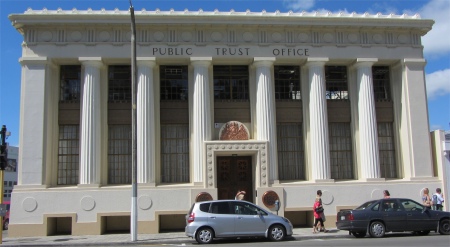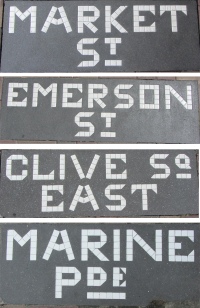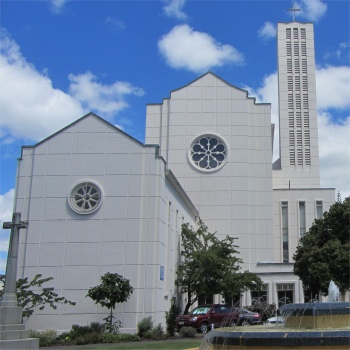
1922 Public Trust Building and Pre-earthquake Classical Revival Design
It's Bulk Enabled it to Withstand the Earthquake
|
I was delighted to wake up to blue skies, today's explore of Art Deco Napier will be all the better for it.
Seasonal Australian whalers arrived in this area of Hawke's Bay in the 1830s. Twenty years later, European settlers arrived, and in 1854 the town was named after Sir Charles Napier, a captain in the British Army in India.
Hawke's Bay also went by the name "the fruit bowl of New Zealand", with orchards groaning under the weight of apples, pears and stone fruit. The environs were also an important grape and wine production area, with the grapes, grown mostly around Hastings, being sent through the Port of Napier for export. But Napier was not necessarily renowned for being a major exporting centre.
The town reached a major turning point in its history on 3rd February, 1931. In two and a half minutes, most of Napier was levelled by an earthquake which registered 7.9 on the Richter scale. The collapse of buildings and the ensuing fires killed 258 people. The centre of the town was completely devastated. The buckling of the earth's surface resulted in 40 sq. km of sea bed now finding itself 2m above sea level; enough extra land to expand the city and provide a site for the airport. The town embraced the opportunity to start afresh, and architect Louis Hay set about designing a new low-rise earthquake-resistant concrete town in the Art Deco style popular at that time. The style's clean simple lines and base relief decoration suited the needs of the new city and expressed all the vigour and optimism of the roaring twenties, and the idealism and escapism of the grim thirties. Although a few Art Deco buildings were replaced with contemporary structures during the 60s, 70s, and 80s, most of the centre remained intact for long enough to become recognized as architecturally important, and beginning in the 1990s it had been protected and restored. Napier and the area of South Beach, Miami, Florida, were considered to be the two best-preserved Art Deco towns in the world. Beginning in 2007, Napier was nominated as a World Heritage Site with UNESCO. This was the first cultural site in New Zealand to be so nominated.

Example of a Splayed Corner at Hildebrandt's
|
Since the town is world famous for its Art Deco standing, a few words on that style would be worthwhile here. The style we now call Art Deco originated in Europe in the early years of the 20th Century, and its heyday was from 1920 to 1940. It became widely known following the great Exposition des Arts Modernes Decoratifs et Industriels, held in Paris in 1925, and from which its name was ultimately derived. By the late 1930s it was in its streamlined phase and after World War II, the International Style, devoid of all decoration, held sway. Not until the late 1960s did people begin to rediscover it and take it seriously. In addition to the Art Deco style, other architectural styles for the period were also used in Napier: the Spanish Mission style from California, and both Stripped Classical and Classical Moderne, the styles of Greece and Rome but simplified and modernised. Its decorative themes included: sunbursts and fountains, the skyscraper shape, symbols of speed, power and flight, geometric shapes, the new woman, breaking the rules and ancient cultures. Soft pastel shades, imitation mud-brick adobes, plastered walls, arched windows and terracotta tiling were another giveaway. In essence, the new style was: fashionable (residents wanted a fresh start), safe (with its emphasis on low relief surface decoration, Art Deco forsook the elaborate applied ornament that had fallen from the buildings in the earthquake and caused so many deaths and injuries), and cheap (its relief stucco ornament was an economical way to beautify buildings during the low point of the Great Depression).

Example Art Deco Features
|
Enhanced by palms and the angular Norfolk Island pines which are its trademark, and bounded by fertile fruit and grape growing plains, dramatic hills and the shores of the South Pacific, beautiful Napier is the centre of the Hawke's Bay region. Napier is steeped in the legacy of its brave rebuilding and the spirit of the optimistic Art Deco era.
As Sir Neil Cossons, Chair of English Heritage and Past President of the British Museums Association once said:
"Napier represents the most complete and significant group of Art Deco buildings in the world, and is comparable with Bath as an example of a planned townscape in a cohesive style. Napier is without doubt unique".
Strolling around the town, it became apparent that many of the streets had been given names of literary luminaries: Tennyson, Byron, Thackeray, Dickens, Shakespeare, Milton and more. The ASB Bank on the corner of Emerson Street incorporated Maori designs. Tennyson Street proffered the Daily Telegraph Building blazoned with zigzags and fountain shapes, the restored Municipal Theatre and the Deco Centre. The Stripped Classical style in Tennyson Street was represented by the Scinde Building adorned in Mayan botanical flourishes, and the Napier Antique Centre with its koru patterns
The new town design after the quake introduced some novel features for the time. All power and telephone lines were buried, a commonplace practice since the 70s, but extremely rare at that time because of the high cost of the cables and of the work involved in burying them. Street lights were suspended over the centrelines of streets.
Thus there was no need for lamp-posts, which raised the issue of where do street names get placed. The answer was to inlay them into concrete slabs set into the footpath.
As part of the road widening programme, buildings were splayed at the corners, to improve visibility for cars, and so Hildebrandt's Building (1933) is splayed while the Public Trust (1922) isn't.
Where it was possible, service lanes were created in the centres of blocks, to enable delivery vehicles to service businesses from the rear.
Another feature that gave Napier its modern appearance was the absence of verandah posts. New buildings were required to cantilever their verandahs over the footpath, at a standard height, supported by steel hangers anchored into the concrete facades. This gave the streets an uncluttered look, like no other town in New Zealand except for Hastings, where the same thing was happening. Previously verandahs were supported by wooden or cast iron posts. Verandahs are common in New Zealand and Australia, and were not built to shelter shoppers from the rain, although they do that very effectively, but to protect the merchandise in shop windows from sun damage.

T&G Building, Daily Telegraph Building and the Deco Centre
|

Example Inlaid Street Names
|

St John's Cathedral
|
Napier's Marine Parade was a spectacular sight with its stately 2km-long boulevard of Norfolk pines and old wooden houses. Beneath the lawns and flower beds of the Marine Parade Gardens lay much of the rubble of the old Napier, placed on to the beach which had doubled in width due to the uplifting of the land by the earthquake by more than 2m. Limestone rubble from the Bluff Hill slip was spread over the debris, then clay and topsoil laid over that. During Art Deco Weekend, the gardens are thronged with people in Deco dress enjoying the Gatsby Picnic.
The Centennial Gardens at the northern end were dominated by a floral clock, the Tom Parker Fountain (which became a light show after dark) and the much photographed statue of Pania of the Reef. Maori legend has it that every evening Pania, a beautiful sea-maiden, would swim from the watery realm of Tangaroa, the ocean god, in order to quench her thirst at a freshwater spring in a clump of flax near the base of Bluff Hill (north of the gardens), and then return to her people each morning. One evening, she was discovered by a young chief who wooed her and wanted her to remain on land. Eventually they married, but when Pania went to pay a final visit to her kin, they forcibly restrained her in the briny depths, and she turned to stone at what was now known as Pania Reef. She reminded me of Copenhagen's Little Mermaid.
Another statue I came across was titled "A Wave in Time", depicting a woman of the Art Deco era with a greyhound. Images of exuberant women with elegant dogs were a popular theme during the Deco period.

